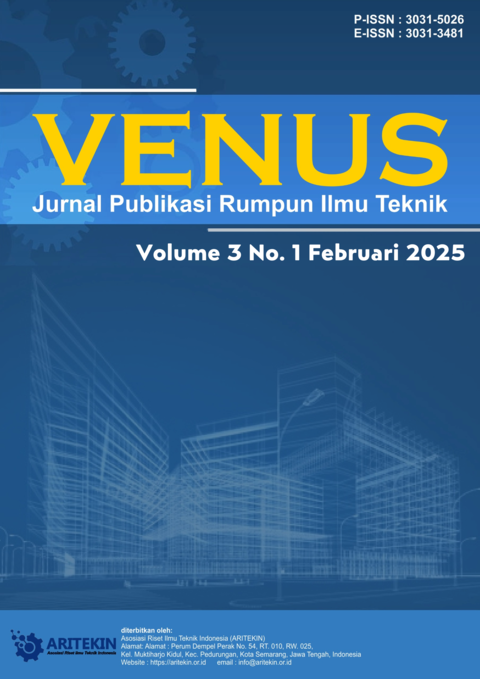Analisis Kualitas Sistem Drainase terhadap Bencana Banjir di Distrik Abepura Kota Jayapura
Studi Kasus : Kelurahan Way Mhorock, Distrik Abepura
DOI:
https://doi.org/10.61132/venus.v3i1.767Keywords:
drainage, flood disaster, sedimentationAbstract
Flood disaster is the most frequent disaster in Indonesia. Based on BNPB records throughout 2021, flood disasters have occurred 1,279 times. Poor drainage system can be one of the factors causing flood disasters. Way Mhorock Village, Abepura District is one of the areas that has poor drainage network quality. This is because Way Mhorock Village is one of the centers of community activities, so it has the potential to cause flooding. This study examines the quality of the drainage system against disasters in Abepura District by focusing on Way Mhorock Village. The research methods used to achieve the objectives in this research are qualitative methods, spatial analysis, and analytical hierarchy process. Qualitative descriptive analysis method to assist and describe the actual drainage problems in the field in the form of pictures. Spatial analysis method using GPS by recording problematic drainage points then processed using ArcGIS software. Analytical Hierarchy Process method by capture the perspective of stakeholders from the agency to determine the assessment of the quality level of the drainage system that has the potential to cause flooding in Way Mhorock Village. The results showed that there are 4 problems that affect the quality of drainage in Way Mhorock Village, namely drainage sedimentation, land use change, drainage cross section, and the volume of waste found at 33 points in Way Mhorock Village. Based on the results of the analytical hierarchy process using an expert choice application, drainage sedimentation is the most influential criterion on improving drainage quality with alternative handling provided in the form of law enforcement policies against environmental violations by the community.
References
Buku
Badan Nasional Penanggulangan Bencana. (2012). Buku saku tanggap tangkas tangguh menghadapi bencana. Jakarta Pusat: Badan Nasional Penanggulangan Bencana.
Badan Standardisasi Nasional. (2003). Tata cara perencanaan lingkungan perumahan di perkotaan. Standar Nasional Indonesia.
Kementerian Pekerjaan Umum. (2020). Petunjuk konstruksi infrastruktur drainase & irigasi. Jakarta Selatan: PISEW.
Noor, Z. Z. (2015). Metodologi penelitian kualitatif dan kuantitatif. Jakarta: Deepublish.
Nugrahani, F. (2014). Metode penelitian kualitatif dalam penelitian pendidikan bahasa. Surakarta: UNS Press.
Sandhyafitri, A. (2015). Mitigasi bencana banjir dan kebakaran. Pekanbaru: UR Press Pekanbaru.
Supriadi, A. (2018). Analytical Hierarchy Process (AHP): Teknik penentuan strategi daya saing kerajinan bordir. Tasikmalaya: Deepublish.
Suripin. (2004). Sistem saluran drainase perkotaan berkelanjutan. Yogyakarta: Andi.
Sutopo, H. B. (2006). Metodologi penelitian kualitatif: Dasar teori dan terapannya dalam penelitian. Surakarta: UNS Press.
Wekke, I. S. (2019). Metode penelitian pendidikan bahasa. Sorong & Jakarta: Gawe Buku.
Wesli. (2008). Drainase perkotaan. Yogyakarta: Graha Ilmu.
Jurnal
Handayani, D. (2005). Pemanfaatan analisis spasial untuk pengolahan data spasial sistem informasi geografis. Jurnal Teknologi Informasi DINAMIK, 10, 108–116.
Helfira, N. (2013). Identifikasi parameter dalam penentuan prioritas penanganan masalah sistem drainase di wilayah Kota Pekanbaru menggunakan metode Analytical Hierarchy Process (AHP). Teknik Sipil, 1–12.
Martono, B. (2014). Analisis dampak kepadatan penduduk terhadap kualitas hidup masyarakat Provinsi Jawa Tengah. Jurnal Ilmiah, 102–114.
Mokonio, O. (2013). Analisis sedimentasi di muara Sungai Saluwangko di Desa Tounelet Kecamatan Kakas Kabupaten Minahasa. Jurnal Sipil Statistik, 1(6).
Nasibu, I. Z. (2009). Penerapan metode AHP dalam sistem pendukung keputusan penempatan karyawan menggunakan aplikasi Expert Choice. Jurnal Pelangi, 2(5), 180–193.
Rahman, D. A. (2018). Komparasi kepadatan dan pertumbuhan penduduk antara urban (perkotaan) dan rural (perdesaan) di Kota Payakumbuh. Jurnal Buana, 2(1), 323–337.
Santoso, D. H. (2019). Penanggulangan bencana banjir berdasarkan tingkat kerentanan dengan metode ecodrainage pada ekosistem karst di Dukuh Tungu, Desa Grimulyo, Kecamatan Panggang, Kabupaten Gunungkidul, DIY. Jurnal Geografi, 7–15.
Dokumen Hukum, Peraturan, dan Perundangan
Indonesia. (2007). Undang-Undang Nomor 24 Tahun 2007 tentang Penanggulangan Bencana. Jakarta: Pemerintah Indonesia.
Keputusan Menteri Kesehatan Republik Indonesia. (2007). Keputusan Menteri Kesehatan Republik Indonesia Nomor 145/Menkes/SK/I/2007 tentang Pedoman Penanggulangan Bencana Bidang Kesehatan.
Peraturan Menteri Pekerjaan Umum Republik Indonesia Nomor 12/PRT/M/2014 tentang Penyelenggaraan Sistem Drainase Perkotaan.
Pusat Krisis Kesehatan Kementerian Kesehatan Republik Indonesia. (2016). Mengetahui jenis-jenis banjir dan cara menanggulanginya. Jakarta Pusat: Kementerian Kesehatan Republik Indonesia.
Pusat Krisis Kesehatan Kementerian Kesehatan Republik Indonesia. (2016). Kenali dampak berbahaya akibat banjir. Jakarta Pusat: Kementerian Kesehatan Republik Indonesia.
Downloads
Published
How to Cite
Issue
Section
License
Copyright (c) 2025 Venus: Jurnal Publikasi Rumpun Ilmu Teknik

This work is licensed under a Creative Commons Attribution-ShareAlike 4.0 International License.






